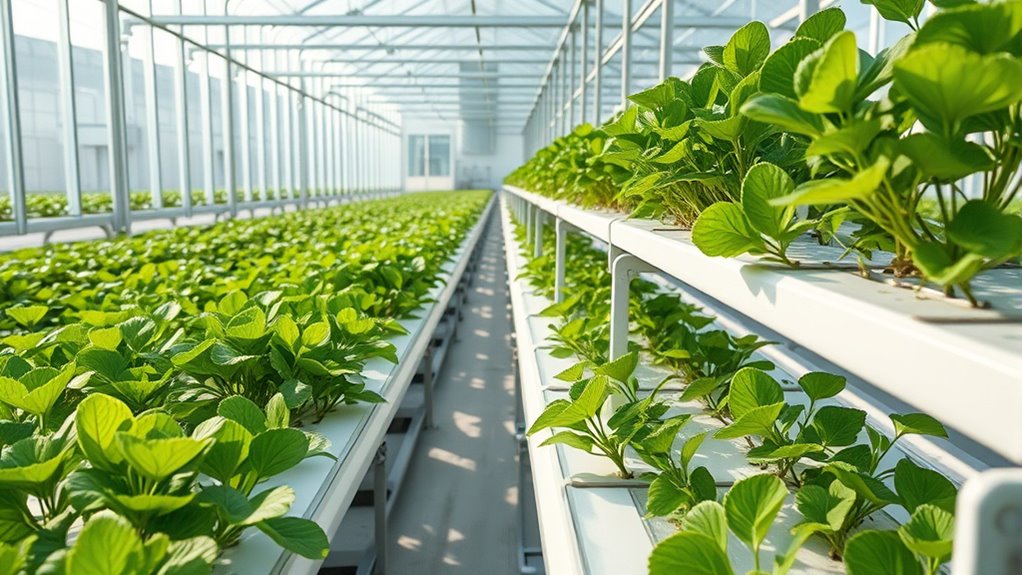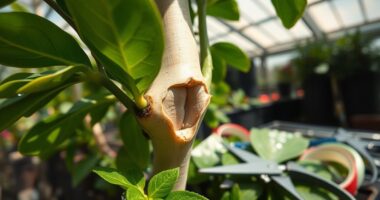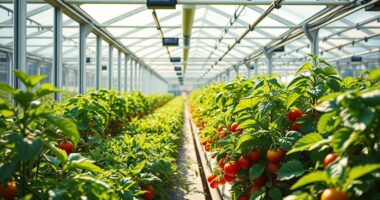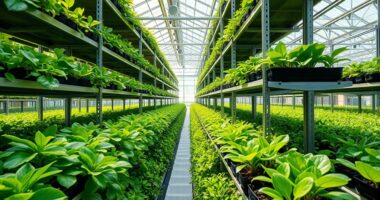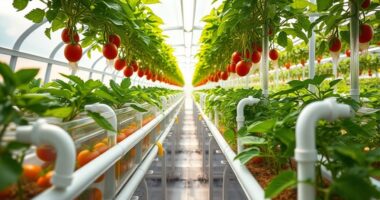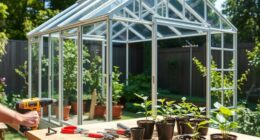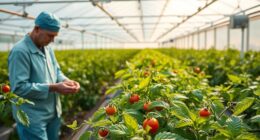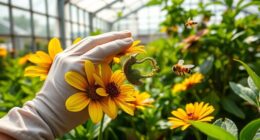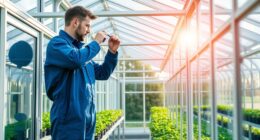Hydroponic systems in greenhouses let you grow plants without soil by delivering nutrient-rich water directly to their roots. They offer precise control over nutrients, leading to faster growth and higher yields. With options like NFT, DWC, or drip systems, you can choose what fits your space and crop needs. These systems also reduce pests and water use, making your greenhouse more sustainable. Keep going to discover how to set up and optimize your hydroponic garden successfully.
Key Takeaways
- Choose suitable hydroponic system types (NFT, DWC, drip) based on greenhouse space and crop needs.
- Maintain optimal nutrient solutions and monitor water quality regularly for healthy plant growth.
- Use controlled environment conditions to minimize pests and reduce chemical pesticide requirements.
- Incorporate AI-driven analytics for precise nutrient dosing and system optimization.
- Benefit from faster crop cycles, higher yields, and water efficiency in greenhouse hydroponic setups.
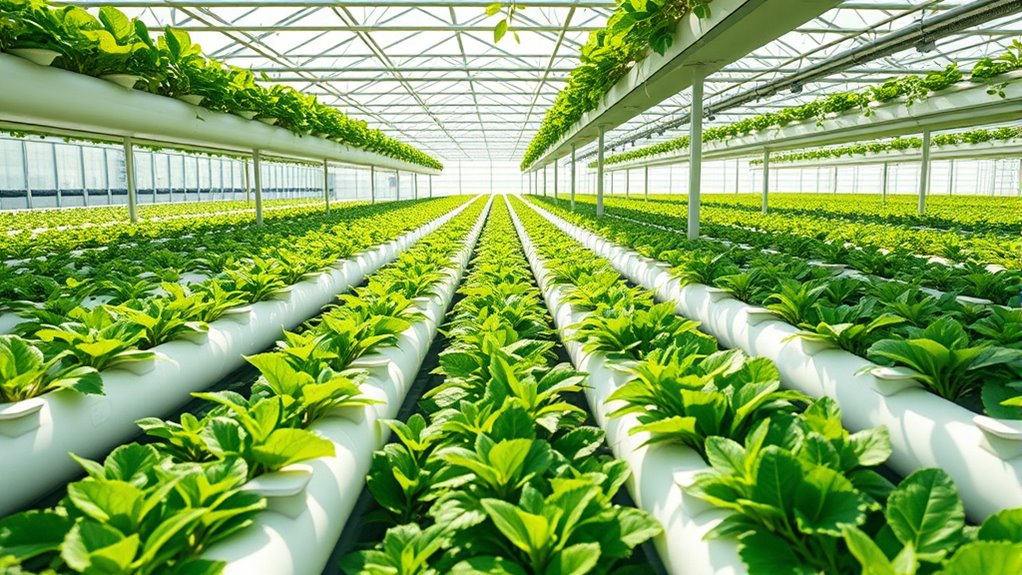
Hydroponic systems are revolutionizing greenhouse farming by allowing you to grow plants without soil, using nutrient-rich water solutions instead. This method offers precise control over the nutrients your plants receive, leading to faster growth and higher yields. Unlike traditional soil-based farming, hydroponics eliminates the need for soil nutrients, reducing issues related to soil depletion and contamination. Instead, you supply plants directly with a carefully balanced mix of essential minerals dissolved in water, ensuring they get exactly what they need for ideal development. This precision means you can tailor nutrient levels to specific crops and growth stages, maximizing productivity while minimizing waste.
Hydroponic farming enables soil-free growth with precise nutrient control for faster, higher-yielding plants.
One of the key advantages of hydroponic systems is their ability to improve pest management. Since you’re not dealing with soil, many soil-borne pests and diseases are eliminated or considerably reduced. This means fewer chemical pesticides are necessary, making your greenhouse environment safer and more sustainable. You can focus on controlling pests through integrated methods like biological controls or physical barriers, which are easier to implement in a soilless setup. Additionally, because the environment is more controlled, pests find it harder to establish themselves, reducing the need for frequent interventions. This streamlined pest management not only protects your plants but also contributes to healthier, more organic produce.
Getting started with hydroponics means understanding the different system types and choosing one that fits your space and crop needs. Popular options like nutrient film technique (NFT), deep water culture (DWC), or drip systems all have unique advantages. Once you select a system, you’ll need to monitor and maintain your water quality, ensuring the nutrient solution remains balanced and free from pathogens. Regular testing helps prevent deficiencies or toxicities that could hinder plant growth. Since you’re bypassing soil, you don’t have to worry about soil-related issues like nutrient lockout or soil-borne diseases, but you must stay vigilant about water sanitation and nutrient dosing. Incorporating AI-driven data analytics can assist in optimizing nutrient levels and detecting potential issues early, further enhancing your hydroponic success.
Incorporating hydroponic systems into your greenhouse can notably boost your productivity and reduce resource use. You’ll save on water, as hydroponics typically use less than traditional methods, and you’ll enjoy fewer pest problems, reducing chemical inputs. Plus, since plants grow faster and often produce higher yields, your investment pays off sooner. By mastering soil nutrients management in a soilless environment and implementing effective pest management strategies, you’ll set yourself up for success in modern greenhouse farming. Hydroponics isn’t just a trend; it’s a sustainable, efficient way to grow healthy, vibrant plants year-round.
Frequently Asked Questions
What Are the Initial Costs of Setting up a Hydroponic Greenhouse?
Starting a hydroponic greenhouse is like planting a seed—you need an initial investment to grow. Your startup costs include equipment like grow lights, nutrient systems, and climate controls, which can range from $5,000 to $20,000 depending on size. While the initial costs may seem high, they set the foundation for a sustainable, efficient operation that can yield faster growth and higher quality crops, making your investment worthwhile.
How Much Maintenance Do Hydroponic Systems Require Regularly?
You’ll need to regularly check your hydroponic system, typically weekly, to guarantee ideal growth. This includes adjusting nutrient levels as plants grow and their needs change. Additionally, you should clean the system periodically to prevent algae and disease buildup. Consistent maintenance, like monitoring pH and replacing water when necessary, helps keep your plants healthy and your system running smoothly, securing a successful hydroponic setup.
Can Hydroponic Systems Be Used for All Plant Types?
Hydroponic systems can be used for most plant types, but plant compatibility depends on specific growth requirements. Some plants thrive in hydroponic setups, while others face growth limitations due to root structure or nutrient needs. You should research each plant’s compatibility before starting, and customize your hydroponic system if necessary. This approach helps maximize growth and guarantees healthy, productive plants in your greenhouse.
What Are Common Pests and Diseases in Hydroponic Greenhouses?
You might think pests and diseases are less common in hydroponic greenhouses, but they do happen. Common pests include aphids, spider mites, and whiteflies, while diseases like root rot and powdery mildew can affect your plants. To keep them at bay, focus on pest management and disease prevention strategies like proper sanitation, airflow, and monitoring. Staying vigilant helps you maintain healthy plants and a thriving hydroponic system.
How Do Hydroponic Systems Impact Overall Greenhouse Energy Use?
Hydroponic systems can improve your greenhouse’s energy efficiency by reducing the need for soil heating and extensive watering. They allow for better climate control, maintaining ideal conditions with less energy. You’ll find that precise water and nutrient delivery minimizes waste and heat loss, leading to lower energy consumption. This setup helps you save on costs while ensuring plants grow healthily, all thanks to enhanced climate control and efficient resource use.
Conclusion
Now that you know the basics of hydroponic systems for greenhouses, you’re ready to start your own setup. Imagine a small greenhouse where you grow fresh herbs year-round using a simple nutrient film technique. With some initial effort, you’ll enjoy faster growth and higher yields. Just like Jane, who boosted her vegetable harvests by switching to hydroponics, you too can transform your gardening experience and enjoy bountiful, healthy plants all year long.
